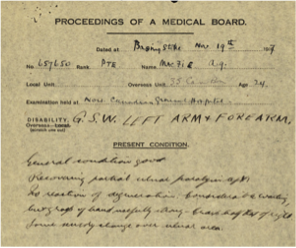MACFIE, PTE ARTHUR Regimental # 657650
Arthur Gill Macfie, was born June 14, 1893 at Sunny Slope, son of Frank ‘F.N.’ Macfie and Mary (Millin) Macfie. Arthur enlisted March 10, 1916 in Parry Sound where he joined the 162nd. The Unit sailed October 31, 1916 on the S.S. Caronia.
On Dec. 9, 1916 Arthur was ‘taken on strength’ in the 35th Battalion and on January 1, 1917 transferred to the 4th Reserve Battalion. On February 26, 1917 he transferred to the 1st Battalion in France.
Arthur suffered a gunshot wound to his arm and forearm on April 5, 1917 at Vimy Ridge. His injury involved damage to his left arm and hand resulting in partial paralysis and he was discharged March 14, 1918.
Arthur Gill Macfie’s story is told in John A. Macfie’s book ‘Letters Home’ pages xvi and xvii. Following a winter in training camps in southern England, Arthur joined the 1st Battalion in the Arras sector. Arthur was wounded in action just before the historic attack on Vimy Ridge. He was hospitalized in England for several months before being sent back to Canada with a partially disabled arm. He died in a farming accident in Sunny Slope in 1919.
As noted in Chapter 1, Veterans Affairs Canada provides the following perspective. “ Vimy Ridge is located in northern France, about 175 kilometres north of Paris. It is a long, high hill that dominates the surrounding landscape. Germany captured Vimy Ridge early in the war and transformed it into a strong defensive position, with a complex system of tunnels and trenches manned by highly trained soldiers with many machine guns and artillery pieces. Previous Allied assaults on Vimy Ridge in 1914 and 1915 had resulted in hundreds of thousands of casualties but had been largely unsuccessful.
The Canadians moved to the front lines across from Vimy Ridge in the late autumn of 1916. The Battle of Vimy Ridge would be the first time all four divisions of the Canadian Corps fought together as one formation. The planning and preparations for the battle were extensive. The Canadians spent the entire winter strengthening the lines, preparing for the assault on Vimy and training rigorously. Models of the trench systems were built and the soldiers drilled on what they were to do. They also raided German positions to gather intelligence on enemy defences.
Extensive “mining” operations were undertaken in which the Allies dug tunnels beneath the German lines and set large caches of explosives to be detonated when the time for the attack came. Elaborate tunnel systems with train tracks, piped water, lights, and huge underground bunkers to stockpile supplies and arms were also established to aid the Canadians in the battle.
To soften enemy defences in preparation for the attack, the Allies made a massive and prolonged artillery barrage. The heaviest shelling was spread over a week to avoid tipping off the Germans on exactly when the assault would begin. More than a million shells rained down during what the Germans called the “Week of Suffering.” The early military aircraft of the day also played a role in the battle by sweeping enemy aircraft and observation balloons from the skies.”
It was during those preparations for the main assault on Vimy that began April 9 that Arthur Macfie was wounded.














